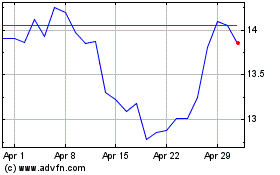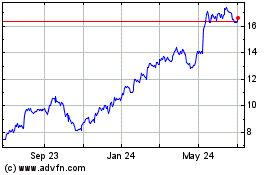Teva Pharmaceutical Industries Ltd. (NYSE and TASE: TEVA) today
announced that new data on its multiple sclerosis (MS) program,
including COPAXONE® (glatiramer acetate injection), a product for
relapsing forms of MS, and laquinimod, an investigational MS
therapy, will be highlighted in 11 presentations at the 7th Joint
Congress of the European Committee for Treatment and Research in
Multiple Sclerosis (ECTRIMS) and Americas Committee for Treatment
and Research in Multiple Sclerosis (ACTRIMS) in Paris, October
25-28, 2017.
“New data from Teva’s MS program further contributes to the
scientific understanding of treating a complex disease like MS,”
said Michael Hayden, MD, PhD, President of Global R&D and Chief
Scientific Officer at Teva. “We look forward to showcasing our
findings at this year’s joint ECTRIMS-ACTRIMS meeting.”
In addition to the data being presented, Teva will also host a
Satellite Symposium, “Maintaining ability in the context of
disability: can we do more for patients?” on October 27, 2017 from
12:45 – 1:45 p.m. CET.
Teva-sponsored Data Include:
COPAXONE® (glatiramer
acetate injection)
[P1.765] Pregnancy Outcomes in Patients With Multiple
Sclerosis and Exposure to Branded Glatiramer Acetate During All
Three Trimesters (Poster Session 1, October 26, 2017, 3:30 –
5:00 p.m.) K. Hellwig, O. Neudorfer, S. Melamed-Gal, P. Baruch
[P2.956] The Effect of Glatiramer Acetate (GA) on Cognitive
Function in an Animal Model of Multiple Sclerosis (Poster
Session 1, October 26, 2017, 3:30 – 5:00 p.m.) R. Aharoni, N.
Schottlender, D.D. Bar Lev, M. Tsoory, M. Sela, R. Arnon
[P2.1210] Higher Medication Satisfaction and Treatment
Adherence in Relapsing-Remitting Multiple Sclerosis Patients
Treated with Glatiramer Acetate 40 mg/mL Three-times Weekly
Compared with 20 mg/mL Daily: 6-Month Results of the CONFIDENCE
Study (Poster Session 2, October 27, 2017, 3:30 – 5:00 p.m.) A.
Veneziano, G. Cutter, M. Al-Banna, S. Rossi, M.N. Zakharova, A.
Boyko, S. Gandhi, R. Everts, A. Grinspan
[P2.1273] Multicenter Open-label Non-interventional Study
Assessing the Alteration of Activity in Ambulatory Patients with
Relapsing Forms of MS (RMS) Under Treatment with
COPAXONE® 40 mg tiw - Results of an Interim Analysis
of the NIS COPTIVITY (Poster Session 2, October 27, 2017, 3:30
– 5:00 p.m.) T. Ziemssen, U. Schulze-Topphoff, D. Fendji
[EP1651] Surface Charge Distribution, an Attribute Linked
with Immunogenicity of Nanoparticles, is Different for Follow-on
Glatiramer Acetate Products Approved in EU, Russia, Latin America,
and USA Compared with COPAXONE® (ePosters will be
displayed for the duration of the congress; however, they will not
be presented during specific sessions) A. Komlosh, R. Krispin, G.
Papir, T. Molotsky, Y. Sahly, V. Weinstein, A. Gilbert, S.
Melamed-Gal, P. Loupe, I. Grossman, R. Laufer, M.R. Hayden
[EP1652] Physicochemical and Biological Characterization of
the European Follow-on Glatiramer Acetate Product as Pompared to
COPAXONE® (ePosters will be displayed on terminals for
the duration of the congress, but will not be presented during
specific sessions) B. Timan, A. Komlosh, O. Beriozkin, A. Konya, K.
Wells-Knecht, V. Weinstein, Y. Sahly, A. Gilbert, S. Melamed-Gal,
P. Loupe, I. Grossman, R. Laufer, M.R. Hayden
[EP1809] Efficacy and Treatment Satisfaction After Switching
Therapy in Patients with Relapsing-Remitting Multiple Sclerosis:
The Multicentre, Observational SURFINIA Study (ePosters will be
displayed on terminals for the duration of the congress, but will
not be presented during specific sessions) R. Mantegazza, M.
Ulivelli, S. Cottone, V. Torri Clerici, M.T. Ferrò, D. De Pascalis,
A. Veneziano, D. Cuomo
[EP1843] The Impact of Nurse Advisors and Online Advice
Services on Treatment Adherence in Multiple Sclerosis (MS)
(ePosters will be displayed on terminals for the duration of the
congress, but will not be presented during specific sessions) A.
Altenbuchner, S. Haug, C. Mohr, U. Scorna, K. Weber
Laquinimod
[P1.431] Transcriptomic Analysis of Disease Reversal in EAE:
Comparison of Laquinimod and FTY-720 (Poster Session 1, October
26, 2017, 3:30 – 5:00 p.m.) H. Belinson, S. Barash, J. Kaye, E.
Raymond, D. Laifenfeld, R. Laufer
[P13.233] CONCERTO: A Placebo-Controlled Trial of Oral
Laquinimod in Patients With Relapsing-Remitting Multiple
Sclerosis (Oral Presentation, Parallel Session 13 – Update on
relapsing-remitting MS management, October 27, 2017, 3:04 – 3:16
p.m.) G. Comi, T.L. Vollmer, A. Boyko, P. Vermersch, T. Ziemssen,
X. Montalban, F.D. Lublin, N. Sasson, Y. Dadon, J.R. Steinerman, V.
Knappertz
[EP1778] Laquinimod Regulates Inflammatory Gene Induction in
a Human Model of Reactive Astrogliosis (ePosters will be
displayed for the duration of the congress; however, they will not
be presented during specific sessions) C. Chapouly, J. Mariani, J.
Zhang, N. Zach, G.R. John
About COPAXONE®
COPAXONE® (glatiramer acetate injection) is indicated for the
treatment of patients with relapsing forms of multiple sclerosis.
The most common side effects of COPAXONE® are redness, pain,
swelling, itching, or a lump at the site of injection, flushing,
rash, shortness of breath, and chest pain. COPAXONE® is rated as
Pregnancy Category B. There are no adequate and well-controlled
studies in pregnant women. Administration of glatiramer acetate by
subcutaneous injection to pregnant rats and rabbits resulted in no
adverse effects on offspring development. Animal reproduction
studies are not always predictive of human response, therefore
COPAXONE® should be used during pregnancy only if clearly needed.
See additional important information at:
www.CopaxonePrescribingInformation.com. For hardcopy
releases, please see enclosed full prescribing information. The
COPAXONE® brand is approved in more than 50 countries worldwide,
including the United States, Russia, Canada, Mexico, Australia,
Israel, and all European countries.
Important Safety Information about COPAXONE®
Patients allergic to glatiramer acetate or mannitol should not
take COPAXONE®. Some patients report a short-term reaction right
after injecting COPAXONE®. This reaction can involve flushing
(feeling of warmth and/or redness), chest tightness or pain with
heart palpitations, anxiety, and trouble breathing. These symptoms
generally appear within minutes of an injection, last about 15
minutes, and go away by themselves without further problems. During
the postmarketing period, there have been reports of patients with
similar symptoms who received emergency medical care. If
symptoms become severe, patients should call the emergency phone
number in their area. Patients should call their doctor right
away if they develop hives, skin rash with irritation, dizziness,
sweating, chest pain, trouble breathing, or severe pain at the
injection site. If any of the above occurs, patients should not
give themselves any more injections until their doctor tells them
to begin again. Chest pain may occur either as part of the
immediate postinjection reaction or on its own. This pain should
only last a few minutes. Patients may experience more than one such
episode, usually beginning at least one month after starting
treatment. Patients should tell their doctor if they experience
chest pain that lasts for a long time or feels very intense. A
permanent indentation under the skin (lipoatrophy or, rarely,
necrosis) at the injection site may occur, due to local destruction
of fat tissue. Patients should follow proper injection technique
and inform their doctor of any skin changes. The most common side
effects of COPAXONE® are redness, pain, swelling, itching, or a
lump at the site of injection, flushing, rash, shortness of breath,
and chest pain. These are not all of the possible side effects of
COPAXONE®. For a complete list, patients should ask their doctor or
pharmacist. Patients should tell their doctor about any side
effects they have while taking COPAXONE®. Patients are encouraged
to report negative side effects of prescription drugs to the FDA.
Visit www.fda.gov/medwatch or call 1-800-FDA-1088.
About Laquinimod
Laquinimod is a once-daily oral, investigational, selective aryl
hydrocarbon receptor (AhR) activator targeting neurodegeneration
and inflammation with a novel mechanism of action being studied for
the treatment of relapsing-remitting MS (RRMS), primary-progressive
MS (PPMS) and Huntington disease.
About Teva
Teva Pharmaceutical Industries Ltd. (NYSE and TASE: TEVA) is a
leading global pharmaceutical company that delivers high-quality,
patient-centric healthcare solutions used by approximately 200
million patients in over 60 markets every day. Headquartered in
Israel, Teva is the world’s largest generic medicines producer,
leveraging its portfolio of more than 1,800 molecules to produce a
wide range of generic products in nearly every therapeutic area. In
specialty medicines, Teva has the world-leading innovative
treatment for multiple sclerosis as well as late-stage development
programs for other disorders of the central nervous system,
including movement disorders, migraine, pain and neurodegenerative
conditions, as well as a broad portfolio of respiratory products.
Teva is leveraging its generics and specialty capabilities in order
to seek new ways of addressing unmet patient needs by combining
drug development with devices, services and technologies. Teva's
net revenues in 2016 were $21.9 billion. For more information,
visit www.tevapharm.com.
Cautionary Note Regarding Forward-Looking Statements
This press release contains forward-looking statements within
the meaning of the Private Securities Litigation Reform Act of 1995
regarding the Company's multiple sclerosis program which are based
on management’s current beliefs and expectations and are subject to
substantial risks and uncertainties, both known and unknown, that
could cause our future results, performance or achievements to
differ significantly from that expressed or implied by such
forward-looking statements. Important factors that could cause or
contribute to such differences include risks relating to:
- The benefits of Copaxone®;
- our specialty medicines business,
including: competition for our specialty products, especially
Copaxone® which faces competition from existing and potential
additional generic versions and orally-administered alternatives;
our ability to achieve expected results from investments in our
product pipeline; competition from companies with greater resources
and capabilities; and the effectiveness of our patents and other
measures to protect our intellectual property rights;
- our business and operations in general,
including: our ability to develop and commercialize additional
pharmaceutical products; manufacturing or quality control problems,
which may damage our reputation for quality production and require
costly remediation; interruptions in our supply chain; disruptions
of our or third party information technology systems or breaches of
our data security; the restructuring of our manufacturing network,
including potential related labor unrest; the impact of continuing
consolidation of our distributors and customers; and variations in
patent laws that may adversely affect our ability to manufacture
our products; our ability to consummate dispositions on terms
acceptable to us; adverse effects of political or economic
instability, major hostilities or terrorism on our significant
worldwide operations; and our ability to successfully bid for
suitable acquisition targets or licensing opportunities, or to
consummate and integrate acquisitions;
- compliance, regulatory and litigation
matters, including: costs and delays resulting from the extensive
governmental regulation to which we are subject; the effects of
reforms in healthcare regulation and reductions in pharmaceutical
pricing, reimbursement and coverage; potential additional adverse
consequences following our resolution with the U.S. government of
our FCPA investigation; governmental investigations into sales and
marketing practices; potential liability for sales of generic
products prior to a final resolution of outstanding patent
litigation; product liability claims; increased government scrutiny
of our patent settlement agreements; failure to comply with
complex Medicare and Medicaid reporting and payment
obligations; and environmental risks;
and other factors discussed in our Annual Report on Form 20-F
for the year ended December 31, 2016 (“Annual Report”),
including in the section captioned “Risk Factors,” and in our other
filings with the U.S. Securities and Exchange Commission,
which are available at www.sec.gov and www.tevapharm.com.
Forward-looking statements speak only as of the date on which they
are made, and we assume no obligation to update or revise any
forward-looking statements or other information contained herein,
whether as a result of new information, future events or otherwise.
You are cautioned not to put undue reliance on these
forward-looking statements.
View source
version on businesswire.com: http://www.businesswire.com/news/home/20171019005116/en/
Teva Pharmaceutical Industries Ltd.IR Contacts:United
StatesKevin C. Mannix, 215-591-8912Ran Meir,
215-591-3033orIsraelTomer Amitai, 972 (3) 926-7656orPR
Contacts:IsraelIris Beck Codner, 972 (3) 926-7687orUnited
StatesDenise Bradley, 215-591-8974
Teva Pharmaceutical Indu... (NYSE:TEVA)
Historical Stock Chart
From Mar 2024 to Apr 2024

Teva Pharmaceutical Indu... (NYSE:TEVA)
Historical Stock Chart
From Apr 2023 to Apr 2024
